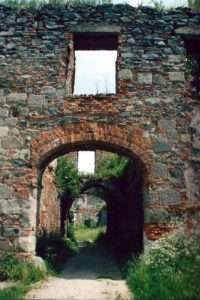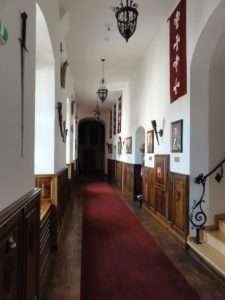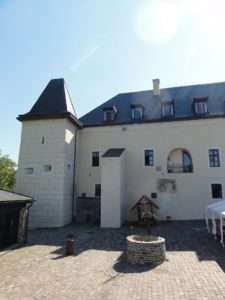Végles
The village of Végles (formerly Véghles or Véglesváralja, Slovak Vígľaš, formerly Podvígleš) is a village in the Gyetva district of Besztercebánya (Banská Bystrica) County, Slovakia. It was built in the Kingdom of Hungary before 1368.

The first mention of Végles Castle dates back to 1390. According to Engel Pál, the castle was built earlier and may have been identical to the hunting lodge called Liget (“in Liget, loco venationis nostrae”) near Zólyom, where King Louis I often stayed between 1368 and 1381. Archaeological evidence has been found for parts of this early castle, but rebuilding in the last third of the 14th century significantly altered and partly obliterated this early castle.

Photo: Civertan
King Louis I and King Zsigmond also stayed in Végles several times, as can be seen from the documents issued here. In 1424, King Zsigmond gave Végles and several castles to his wife, Cillei Borbála. In 1429 the royal castellan was Czekei Márton and the vice-castellan was Chery Péter. Their main task was to lead the royal hunts.

In 1438, King Habsburg Albert deprived his mother-in-law of the lands that Zsigmond had given him, leaving him with only the castles of Zólyom, Végles, Saskő, Dobronya, and Lipcse. In 1439, these castles also became the property of Queen Erzsébet, who took them over as her own after Albert’s death. According to the archives of the Justh family, King Albert exchanged the castle of Cserép with Kussowi (Justh) Jodok for Végles, which then became the honorary property of the Justh family.

Photo: Szegedi Szabolcs
On 5 August 1440, Queen Erzsébet gave the castle and manor of Végles as a pledge to Eberstorff Reinprecht, who had given her the castle and town of Staincz in Moravia, along with 5000 gold forints. The queen summoned the Bohemian mercenary leader Giskra to the country and made him lord of the castle of Zólyom. Giskra appointed his own men, Jodok Kussowi (Jost, Just) and Hennig Cernin, as lords of Végles Castle on behalf of the queen, but the castle remained the property of the queen.

In 1446 a treaty was signed between the Hungarian lords and Giskra, in which 4 castles in Zólyom County, namely Végles, Saskő, Dobronya, and (Zólyom) Lipcse, were ceded to Giskra by hereditary right. In 1455 Henning sold his part of the Végles estate to Jodok Kussowi.

In 1451, Jodok became a supporter of Governor Hunyadi János, so that he could keep Végles during the reign of King Matthias. According to a charter issued by King Matthias on 30 July 1464, Jodok (‘Jodok of Cwsaw’) was still captain of the castle of Végles (‘Wyglesch’) at that time. After his death, his son Justh András became the owner of Végles. In 1492 King Ulászló II forbade the castellans and their men from the castles of Zólyom and Dobronya to enter the forest of Justh András and to hunt any kind of game.

In 1497 Ráskai Balázs bought it from Justh András in exchange for the castle of Solymár. In 1520 it was in the hands of Ráskai Gáspár. After Mohács, Ráskai Gáspár and his brother also became supporters of King Szapolyai János. The pro-Ferdinand captain of Zólyom, Thurn Kristóf occupied it around 1530. On the 7th of June, Thurn took and plundered Garamszentbenedek Abbey. He transported the valuables and the archives to the castle of Végles.

In 1542, Act X of the Besztercebány (Banská Bystrica) Law provided for the restitution of the castles of Végles, Lipcse, and Dobronya, which had been occupied by Thurn on behalf of Queen Mária (the widow of King Lajos II), as Thurn had occupied them for himself and his family. Végles had to be returned to Ráskai István, Dobronya to Werbőczy Imre, and Lipcse to the Lipcsei and Dóczi families of Nagylucsse.

The Thurn family held Végles until 1549 when it was returned to the king. It is interesting to note that in 1547 the inventory of the castle contained 4,681 lead-coated cannonballs. Sometime after 1549, Pethő János bought Végles from the king.
In 1551 the king bought the castle of Végles from Pethő János for 9000 forints. In 1552, Maschko Menyhért, the captain of Végles, took part in the battle of Palást with 250 horsemen, where he was captured and released only after paying a ransom. In February 1557 Maschko was still captain of Végles, but in the same year, the castellan Thayninger Egyed of Végles was mentioned in a court document.

In 1558 the king pledged it to Dobó István for 20500 gold. Dobó appointed Zeleméry László, a relative of Dobó, to be the foreman of the castle, who fortified it and built a tower and a bastion in 1566. In 1564 Zeleméry repulsed a major Turkish attack from under the castle. In 1568, King Miksa (Maximilian) pledged the castle to Balassa Farkas for 10,000 gold pieces.

The widow of Balassa Farkas married Baron Zay László, who also became the lord of Végles. 1/3 of the castle of Végles went to Zay László, 2/3 to Balassi László. The king redeemed Zay László’s part, and in 1581 King Rudolf paid them a third instalment of 7000 forints for 1/3 of the castle of Végles.

In July 1575 the Turks captured the castles of Kékkő and Divény. To protect the mining towns, the Military Council took several measures, such as damming the Szalatna Valley in the foothills of Zólyom and Végles into a lake. Act 27 of 1578 ordered the county of Lipó to carry out 12 days of manual and wheel labor on the fortification of Végles. In 1582 the castle was guarded by 100 German mercenaries, and in 1583 by 200.

Balassa László died in 1585 and in his last will, he left his property to Balassi Bálint, Ferenc, and Balassa András. A month later, Archduke Ernst ordered the captain of Végles, Tapolcsányi János, to hand over the castle to Balassa András. Balassi Bálint wanted to occupy Végles, but he was prevented by Dobó Ferenc, the chief captain of the Western Danube region. Finally, Archduke Ernst got fed up with the Balassa relatives’ bickering and expelled all 3 Balassa from the Végles estate. By royal decree, Végles became the property of Balassa András, but the king kept 1/3 of it.

On 01.08.1585 Archduke Ernst wrote a letter of complaint to the Pasha of Buda, Sinan, about the Turkish raids near Végles. In 1589 the castle was partly burnt down. Thanhauser Honor, the captain of Végles, asked for help from Körmöcbánya to restore the castle.
In 1591, Balassa András had not yet paid the pledge for Végles, so the Hungarian Chamber asked Archduke Matthias if the castle could be pledged to someone else. In 1592, Balassa Zsigmond and Imre declared that they had given Végles to His Majesty. However, according to a letter from Archduke Matthias dated 23 May 1593, they were still in possession of the castle. However, Balassi Bálint also reported to the Archduke for the possession of Végles, who, according to his correspondence, was already annoyed by the Balassa feud.

At the beginning of 1605, Bocskai’s commander Rhédey Ferenc, following the retreating troops of General Basta, took Végles, Zólyom Castle, Besztercebánya and then Léva in a short siege. From there he set out to conquer Nyitra. Only after the Treaty of Vienna did Végles return to the Kingdom of Hungary.

In July 1607 the manor of Végles was given by the Chamber to Pogrányi Benedek. In 1621 Daróczi István and Herencsényi István, captains of Fülek, captured Bethlen’s follower, the sickly Rhédey Ferenc, who died in Fülek. Bethlen’s troops defeated Daróczi’s troops at Végles and captured Daróczi himself, who was later impaled in the main square of Várad for Rhédey’s death. Shortly afterwards, Herencsényi surrendered Fülek Castle to Bethlen. Bethlen’s soldiers retreated from the castle in May 1624.

On 17.09.1631, Cardinal Pázmány Péter requested the transfer of the Végles estate to the Church, but this was not done. On the 4th of July 1636, the buildings and weapons of the castle were inventoried. “…the fourth small round bastion is 16 paces in circumference…”. The castle then had stables, a tool shed, and three stables for six horses, boarded up. The outer wall of the castle was “fenced with pine posts twenty-two paces high, the middle of which was filled with earth”.

Old and new weapons: halberds, two-handed swords, brass syringes, tools. Wreaths of pine needles, fiery arrows, iron spears without shafts. “Iron lamp pans, stone picks, gunpowder, wicks, fireballs in pots. Howitzers with the date of their casting (e.g. 1532), coats of arms, e.g. the name and coat of arms of “Christoph Fon Turu”, their place on the bastions; names of the bastions. The castle and the manor were pledged to Pogrányi János.

In 1638 Count Csáky László acquired Végles as a donation in perpetuity. According to a letter written by the “Kuruc” refugees to Teleki Mihály on 23 November 1678, the castle of Végles was in their hands. They wrote: “Now, by the grace of God, all the mining towns and the castles around them, Zólyom, Lipcse, Végles, Devin, Kékkő, Saskő, Revistye, are in our hands… ”
The second part of the letter states that the imperial troops led by General Leslie and Koháry have retaken the mining towns and castles.

In 1682 Thököly and the Turkish Ibrahim Pasha of Buda besieged Fülek. Végles also opened its gates to the Kuruc forces and Jánoky Zsigmond became the castellan. After the unsuccessful siege of Vienna in 1683, Thököly and his troops were expelled from Zólyom County. In 1690 the Zólyom branch of the Esterházy family bought the castle and the manor house, which remained their property until 1869.

After the outbreak of the Rákóczi War of Independence in the autumn of 1703, Géczy Zsigmond, the former captain of Thököly, captured Divény and Végles in a Kuruc attack. On 15 November the imperial troops were defeated under Zólyom, and on 23 November Bercsényi besieged the town of Zólyom.

At the end of October 1708, Bercsényi wanted to send guards to the castle, but Viard’s imperial troops overtook the Kuruc troops and occupied Végles. Until the end of the War of Independence, there was an imperial guard of 40 men in the castle. After 1711, the Esterházys took back the castle and used it as a manor house. The administration of the Végles estate was initially under the supervision of the Inspectorate of Léva, but after 1794 it came under the jurisdiction of the Prefect of the Nagybiccse District, whose headquarters were initially in Nagybiccse and under the Central Property Directorate in Kismarton.

In 1869, Nemeskéri Kiss Miklós, a former colonel in the Hungarian army of 1848, bought the Végles estate from the Esterházys. Nemeskéri had it rebuilt into a hunting lodge in 1870. His son Pál sold the estate to Archduke Friedrich Habsburg-Teschen in 1908. After the Treaty of Trianon, the Czechoslovak State Forestry Directorate moved into the building. In February 1945, during the fighting between Soviet and German troops, the castle was set on fire and damaged. The ruined and abandoned castle was transformed into a luxury hotel in 2009.
Enjoy the video of Szegedi Szabolcs:
Source: Várlexikon https://varlexikon.hu/vegles
Dear Readers, I can only make this content available through small donations or by selling my books or T-shirts:
Please, feel free to support me with a coffee here:
You can check out my books on Amazon or Draft2Digital, they are available in hardcover, paperback, or ebook:
https://www.amazon.com/dp/198020490X or at https://books2read.com/b/boYd81

My work can also be followed and supported on Patreon: Become a Patron!http://Become a Patron!
[wpedon id=”9140″]

https://hungarianottomanwars.myspreadshop.com/all

































































